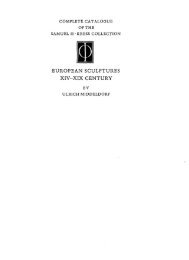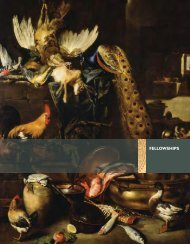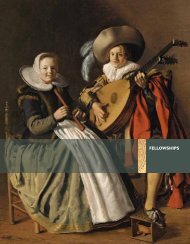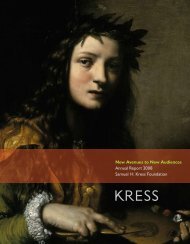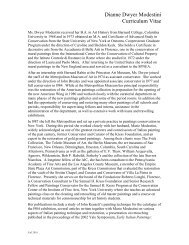The Campus Art Museum - Samuel H. Kress Foundation
The Campus Art Museum - Samuel H. Kress Foundation
The Campus Art Museum - Samuel H. Kress Foundation
You also want an ePaper? Increase the reach of your titles
YUMPU automatically turns print PDFs into web optimized ePapers that Google loves.
e seen within other, for lack of a better word, emotions? And love is something<br />
that would engage most college students and our laboratory is, in essence, the<br />
artwork. And so one question is whether there is a difference between Eastern<br />
and Western portrayals of love. But we also ask whether the portrayals of love<br />
in art are true to what scientists would say should be happening in the bodies.<br />
For another example of comparative analysis, a professor of fashion design<br />
and clothing construction takes her students to the campus art museum to look<br />
at how styles change over time and to link changes in clothing and fabrics to the<br />
larger socio-political context:<br />
For the fashion student, [the art museum has] been so extremely valuable to<br />
understand clothing better, to understand even what nudity means. Is nudity<br />
glamour or is it what is done to the imprisoned? …I bring all the textile<br />
students here [to the campus art museum] because they need to see what fabric<br />
has meant over time.<br />
<strong>The</strong>se cases from anthropology, biology, and fashion design represent several<br />
of the disciplines where professors have learned how art can engage students in<br />
comparative analysis of a concept, behavior, or materiality across cultures and<br />
over time. Another way that professors and curators/educators use art is to critique<br />
societal issues as touched upon next.<br />
Critiquing Social Issues<br />
Perhaps because the art museums in this study are on college and university<br />
campuses, curators are not hesitant to address hot issues or engage in social critique<br />
through special exhibitions. <strong>The</strong>se are sometimes done in conjunction with specific<br />
courses or become drawing cards for classes examining similar issues. For example,<br />
campus art museums in this study have had exhibitions on censorship, the “sex<br />
of art,” nudity and nakedness, anorexia, the politics of photography, etc. Such<br />
exhibitions attract classes in gender studies, sociology, journalism, and literature,<br />
in particular. Exhibitions that explore societal issues tend to generate great interest<br />
on campus because they connect to students’ personal lives and their questioning<br />
of societal values. <strong>The</strong>y also allow the curator to “rediscover parts of the collection<br />
that haven’t been used for years.” Of course, exhibitions that employ social<br />
critique or that are edgy sometimes become the object of critique themselves as a<br />
curator of education described: “We still sometimes get in trouble with students<br />
or their families. <strong>The</strong>y’ll say, ‘How dreadful for [the university] to spend money on<br />
something like that.’”<br />
<strong>Museum</strong> staff talk also about using artwork as a means to engage students<br />
in conversations about social issues such as racism, sexism, prejudice, and<br />
stereotyping. An academic curator refers to this as “difficult dialogue” talk—a<br />
discussion that is “object-centered, but used to talk about difficult ethical situations,<br />
such as abortion or racial inequities.” <strong>The</strong> paintings or museum objects help to<br />
provide a “safe space” for the conversations, and in the process, according to<br />
the curator, “the object becomes a participant in the dialogue.” An art historian<br />
Meeting Course Objectives through the <strong>Art</strong> <strong>Museum</strong><br />
16



